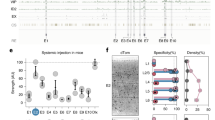Abstract
Although our understanding of the mechanisms that underlie drug addiction have advanced significantly over the past few decades, the lack of efficacious treatments for this debilitating disorder suggest that there is much work still to be done to clarify the role of specific cells and circuits in the process that govern addiction. In recent years, new technologies have been developed that are now allowing researchers to express transgenes in selective cell populations in the brain as well as to modulate the activity of these cell populations selectively. This chapter provides a detailed overview of how cell-type-specific viral vectors can be developed and used in order to parse out the neural circuits that underlie addiction.
Access this chapter
Tax calculation will be finalised at checkout
Purchases are for personal use only
Similar content being viewed by others
References
Kalivas PW (2002) Neurocircuitry of addiction. In: Davis KL, Charney D, Coyle JT, Nemeroff C (eds) Neuropsychopharmacology: the fifth generation of progress. Lippincott, Williams, & Wilkins, Philadelphia, PA, pp 1357–1366
Kauer JA, Malenka RC (2007) Synaptic plasticity and addiction. Nat Rev Neurosci 8(11): 844–858
Nestler EJ (2005) Is there a common molecular pathway for addiction. Nat Neurosci 8(11):1445–1449
Robinson TE, Berridge KC (2001) Incentive-sensitization and addiction. Addiction 96(1):103–114
Robison AJ, Nestler EJ (2011) Transcriptional and epigenetic mechanisms of addiction. Nat Rev Neurosci 12(11):623–637
Deller T, Frotscher M (1997) Lesion-induced plasticity of central neurons: sprouting of single fibres in the rat hippocampus after unilateral entorhinal cortex lesion. Prog Neurobiol 53(6):687–727
Rogan SC, Roth BL (2011) Remote control of neuronal signaling. Pharmacol Rev 63:291–315
Armbruster BN, Li X, Pausch MH, Herlitze S, Roth BL (2007) Evolving the lock to fit the key to create a family of G protein-coupled receptors potently activated by an inert ligand. Proc Natl Acad Sci USA 104:5163–5168
Ferguson SM, Eskenazi D, Ishikawa M, Wanat MJ, Phillips PE, Dong Y et al (2011) Transient neuronal inhibition reveals opposing roles of indirect and direct pathways in sensitization. Nat Neurosci 14:22–24
Kreitzer AC, Berke JD (2011) Investigating striatal function through cell-type specific manipulations. Neuroscience 198:19–26
Lobo MK, Covington HE III, Chaudhury D, Friedman AK, Sun H, Damez-Wemo D, Dietz DM, Zaman S, Koo JW, Kennedy PJ, Mouzon E, Mogri M, Neve RL, Deisseroth K, Han MH, Nestler EJ (2010) Cell type-specific loss of BDNF signaling mimics optogenetic control of cocaine reward. Science 330(6002):385–390
Stuber GD, Sparta DR, Stamatakis AM, van Leeuwen WA, Hardjoprajitno JE, Cho S, Tye KM, Kempadoo KA, Zhang F, Deisseroth K, Bonci A (2011) Excitatory transmission from the amygdala to nucleus accumbens facilitates reward seeking. Nature 475(7356):377–380
Pastrana E (2011) Rewiring cellular networks. Nat Methods 8(2):108–109
Neve RL, Neve KA, Nestler EJ, Carlezon WA (2005) Use of herpes virus amplicon vectors to study brain disorders. Biotechniques 39(3): 381–391
Wu Z, Yang H, Colosi P (2010) Effect of genome size on AAV vector packaging. Mol Ther 18(1):80–86
Funston GM, Kallioinen SE, de Felipe P, Ryan MD, Iggo RD (2008) Expression of heterologous genes in oncolytic adenoviruses using picornaviral 2A sequences that trigger ribosome skipping. J Gen Virol 89:389–396
Barot SK, Ferguson SM, Neumaier JF (2007) 5-HT1B receptors in nucleus accumbens efferents enhance both rewarding and aversive effects of cocaine. Eur J Neurosci 25(10): 3125–3131
Olmstead MCC (2010) Animal models of drug addiction. New York: Humana Press
Ferguson SM, Neumaier JF (2012) Grateful DREADDs: engineered receptors reveal how neural circuits regulate behavior. Neuropsychopharmacology 37(1):296–297
Alexander GM, Rogan SC, Abbas AI, Armbruster BN, Pei Y, Allen JA, Nonneman RJ, Hartmann J, Moy SS, Nicolelis MA, McNamara JO, Roth BL (2009) Remote control of neuronal activity in transgenic mice expressing evolved G protein-coupled receptors. Neuron 63:27–39
Fenno L, Yizhar O, Deisseroth K (2011) The development and application of optogenetics. Annu Rev Neurosci 34:389–412
Zhang F, Aravanis AM, Adamantidis A, de Lecea L, Deisseroth K (2007) Circuit-breakers: optical technologies for probing neural signals and systems. Nat Rev Neurosci 8(8):577–581
Author information
Authors and Affiliations
Editor information
Editors and Affiliations
Rights and permissions
Copyright information
© 2014 Springer Science+Business Media, LLC
About this protocol
Cite this protocol
Ferguson, S.M., Neumaier, J.F. (2014). Development of Cell-Type-Specific Viral Vectors to Tease Apart the Neural Circuitry that Contributes to Drug Addiction. In: Brambilla, R. (eds) Viral Vector Approaches in Neurobiology and Brain Diseases. Neuromethods, vol 82. Humana Press, Totowa, NJ. https://doi.org/10.1007/978-1-62703-610-8_8
Download citation
DOI: https://doi.org/10.1007/978-1-62703-610-8_8
Published:
Publisher Name: Humana Press, Totowa, NJ
Print ISBN: 978-1-62703-609-2
Online ISBN: 978-1-62703-610-8
eBook Packages: Springer Protocols




